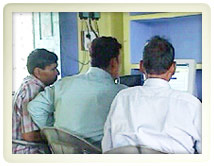Community Embraces New Word Game at Mid-Year Play Day This past Sunday, families at Takoma Park’s Seventh Annual Mid-Year Play Day had the opportunity to experience OtherWordly for the first time. Our educational language game drew curious children and parents to our table throughout the afternoon. Words in Space Several children gathered around our iPads […]
Read moreBridging the digital divide requires flexibility.
 In a village meeting, adults get the weekly news and discuss the pressing issues of the day – a far cry from the technology parks and campuses that are driving the Indian technology boom. |
Problem
Should we take the practices of our technological culture into emerging technological cultures?
Solution
No. Provide the basics and allow individuals and communities create their own adaptations.
Discussion
The “digital divide” between people with access and skills to use technology – and those without – is an alarming imbalance, especially since technology has great potential to lower marginal costs of helping people, and to solve problems where other solutions have failed.
Those without full access to technology are often located in rural areas, where low-density populations do not justify investments in infrastructure. They may also live in countries where neither the economy nor education has gathered enough strength to bring the other along on an upward path to technological access. Indeed, even when businesses from technologically advanced areas set up operations in less developed areas and promise infrastructure improvements, worker training, and technology transfer, the benefit to the local population is often limited.
 The United Nations Working Group on Internet Governance considers issues and policy related to technology; stakeholder interests; and the financial, environmental, and cultural costs of information technology, particularly in capacity-building efforts in developing countries. |
Cultural issues of learning through technology:
- Connecting to the Internet: A tremendous amount of physical and social infrastructure is needed to get online. Can we generalize American cultural changes that have arise from the use of the Internet to other cultures, and, if so, are we obligated to communicate them to communities that are just beginning to adopt technology?
- Dependency: Technological tools can create dependency. For example, calculators have become so ubiquitous in our culture that many people cannot explain or perform mathematical functions – today’s children can’t do basic math in their heads. Will having technological tools interrupt the fundamental legacy of developing cultures?
- Literacy: Although computers are being used to overcome literacy deficits, such deficits are often expediently bypassed through the use of online pictures, animation, and audio. Is it the responsibility of the donor/teacher to design implementations that assess successful communication and authentic learning, or is that a luxury that underserved populations in need of immediate answers can ill afford?
- Credibility: Technologically advanced cultures must still be reminded that information garnered from the Internet may or may not be true. Do less technologically advanced cultures require a “super-user” to parse information? Or should efforts to introduce technology encourage real learning through trial-and-error, intermittent failure, and the development of critical thinking skills?
- Social Costs: When compared to traditional, face-to-face teaching and learning, does online education result in a loss of community? The idea of “scaffolding” – the pedagogy that enables learning a step above where the learner is now by leading him there – can happen among people in a group (from peer to peer) or an individual being so led online.
- Paving the Way: Should we consciously separate the introduction of technology into communities that need and want to learn from our own cultural practices? For example, a communitarian approach to online learning is likely to be an entirely different experience from that of the American holed up for days in front of his screen. Envision, rather, a community gathered in a tech center, in a culture in which all-important information has been handed down for generations.
Sharing Information and Ideas
While money and resources are zero-sum, ideas are not. Yet it is perhaps easier to providing funding for technology than it is to agree upon strategies for successful online learning. Our difficulty in deciding upon standards for success in technologically advanced cultures is compounded when we contemplate transferring it to underserved cultures. Acquiring a clear understanding of how environment and culture drive successful teaching and learning presents more obstacles than simply providing equipment.
Because educators and instructional designers haven’t reached a consensus on how to best replicate online learning in unpredictable environments, adaptive models for progress, such as those take from Complex Adaptive Systems, provide the flexibility needed to bridge the digital divide.

